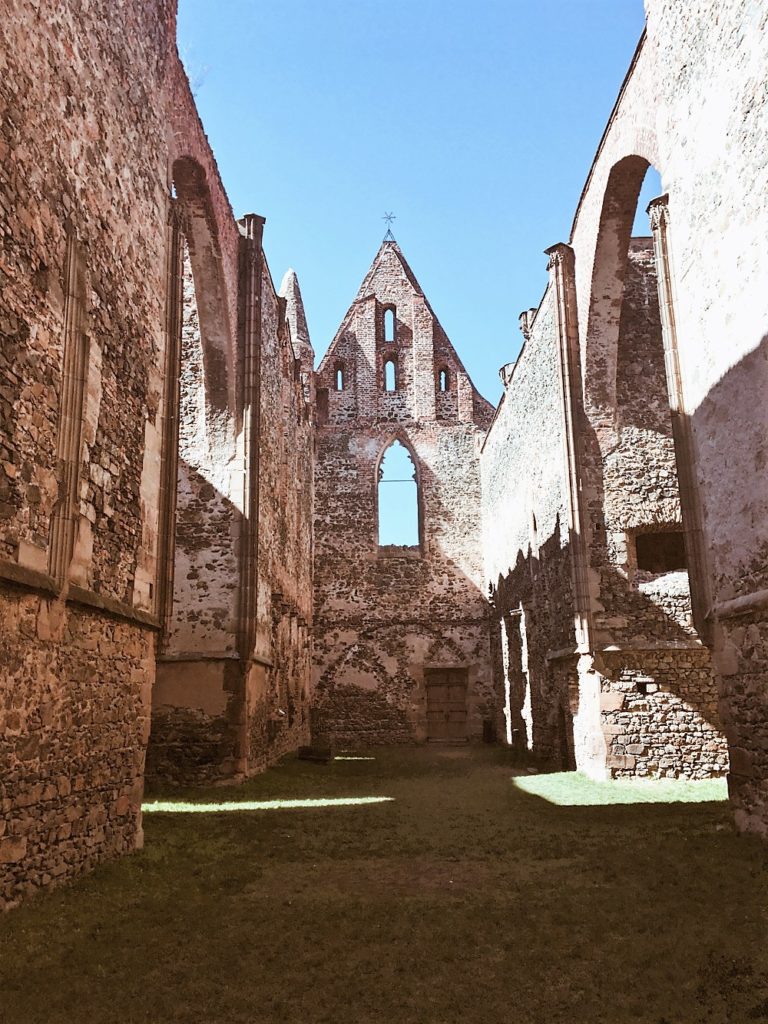Rosa Coeli – the mysterious Gothic

I’d been thinking about this trip for quite some time. Despite seeing gorgeous photographs and reading favorable suggestions, I was too busy to come until one day. I had not planned it; I simply got up, glanced out the window, and saw a gorgeous sunny day after a long winter, so I couldn’t stay at home. The decision has been made. This was the day I wanted to see the renowned Rosa Coeli.
We arrived at Dolní Kounice town after only 20 minutes of driving. We were pleasantly delighted by what we witnessed when we initially arrived in the town. I hadn’t done any research on this place before, so I had no idea what to anticipate. Dolní Kounice, located in the valley of the Jihlava river, has a long history dating back to the Roman Empire. Wealthy aristocrats and tradesmen were interested in the town, as can be seen and felt at every corner.
It was the beginning of spring, and there were few tourists at the entrance to the convent’s ruins. You can visit the convent with a guide or on your own, with texts. There is an additional price for taking photos, but I believe the price is reasonable when compared to rates at famous castles and chateaux. We decided on a guided tour. With only 30 minutes until the start, we explored the area on our own. I was so pleased about what I saw that I couldn’t stop taking pictures. Those who know me know that I prefer to admire stuff with my eyes rather than my camera. Would they be astonished to see me?
The convent’s current entry is through the cathedral portal, but the original entrance was through a three-nave basilica that was turned into a block with a cloister in the center when the adjacent Gothic cathedral was completed. The monastery was created by the lord Vilem Pulin as a form of redemption for his offenses against Austrians, to whom he had caused property damage during the battle over the right of control of border areas. The Roman Pope cursed him for these offenses.


Construction on the original basilica began in 1181, and the first nuns of the Premonstratensian order arrived in 1183. The intention was to provide space for approximately 100 nuns, but this did not happen. The maximum number of nuns present at one time was 45. The construction of the Gothic Cathedral began in the 14th century, with the backing of Charles IV of Luxembourg. There are almost no written records about the convent, and historians can only speculate on how it burned down for the first time. It is thought that this occurred occasionally during the Hussit wars in the first half of the 15th century. However, the order rectified the buildings’ damages and allowed them to resume their normal lives.
In 1926, the commission for repairing monuments in Dolní Kounice was established. Volunteers completed the restoration work, and it is thanks to them that we may now appreciate this medieval sleeping beauty.
The ruins of the ancient Virgin Mary church with its ambit and cloister have remained. Nuns’ living quarters have not remained unchanged. When wandering around the church nave and cloister, be careful that beneath your feet are the buried remains of nuns and convent supporters. Only two gravestones remained. One gravestone is built of a sand stone that dates back to the Devonian age (416-359 million years ago), which my spouse greatly loved, so I need to mention it.
The name Rosa Coeli translates as “the Rose of the Heaven,” which sounds extremely beautiful, but nuns’ lives were everything but romantic. They died at a young age despite living under extremely harsh conditions of continual cold and humidity. They had no contact with the outside world, and it was fairly uncommon for some nuns to be compelled to join the order because their parents could not afford to marry them.

The place has a mystic atmosphere and definitely worth visiting. For booking trip to Rosa Coeli please contact us.





